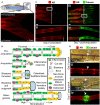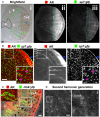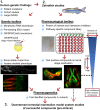Zebrafish as an Emerging Model for Osteoporosis: A Primary Testing Platform for Screening New Osteo-Active Compounds
- PMID: 30761080
- PMCID: PMC6361756
- DOI: 10.3389/fendo.2019.00006
Zebrafish as an Emerging Model for Osteoporosis: A Primary Testing Platform for Screening New Osteo-Active Compounds
Abstract
Osteoporosis is metabolic bone disease caused by an altered balance between bone anabolism and catabolism. This dysregulated balance is responsible for fragile bones that fracture easily after minor falls. With an aging population, the incidence is rising and as yet pharmaceutical options to restore this imbalance is limited, especially stimulating osteoblast bone-building activity. Excitingly, output from large genetic studies on people with high bone mass (HBM) cases and genome wide association studies (GWAS) on the population, yielded new insights into pathways containing osteo-anabolic players that have potential for drug target development. However, a bottleneck in development of new treatments targeting these putative osteo-anabolic genes is the lack of animal models for rapid and affordable testing to generate functional data and that simultaneously can be used as a compound testing platform. Zebrafish, a small teleost fish, are increasingly used in functional genomics and drug screening assays which resulted in new treatments in the clinic for other diseases. In this review we outline the zebrafish as a powerful model for osteoporosis research to validate potential therapeutic candidates, describe the tools and assays that can be used to study bone homeostasis, and affordable (semi-)high-throughput compound testing.
Keywords: animal model; drug development; genetic mutants; osteoblast; osteoclast; osteoporosis; screening; zebrafish.
Figures







Similar articles
-
A Rare Mutation in SMAD9 Associated With High Bone Mass Identifies the SMAD-Dependent BMP Signaling Pathway as a Potential Anabolic Target for Osteoporosis.J Bone Miner Res. 2020 Jan;35(1):92-105. doi: 10.1002/jbmr.3875. Epub 2019 Nov 14. J Bone Miner Res. 2020. PMID: 31525280 Free PMC article.
-
Lrp5 Mutant and Crispant Zebrafish Faithfully Model Human Osteoporosis, Establishing the Zebrafish as a Platform for CRISPR-Based Functional Screening of Osteoporosis Candidate Genes.J Bone Miner Res. 2021 Sep;36(9):1749-1764. doi: 10.1002/jbmr.4327. Epub 2021 May 19. J Bone Miner Res. 2021. PMID: 33957005
-
ZFBONE: An ImageJ toolset for semi-automatic analysis of zebrafish bone structures.Bone. 2020 Sep;138:115480. doi: 10.1016/j.bone.2020.115480. Epub 2020 Jun 11. Bone. 2020. PMID: 32534223
-
Opportunities and Challenges in Functional Genomics Research in Osteoporosis: Report From a Workshop Held by the Causes Working Group of the Osteoporosis and Bone Research Academy of the Royal Osteoporosis Society on October 5th 2020.Front Endocrinol (Lausanne). 2021 Feb 15;11:630875. doi: 10.3389/fendo.2020.630875. eCollection 2020. Front Endocrinol (Lausanne). 2021. PMID: 33658983 Free PMC article. Review.
-
Functional Validation of Osteoporosis Genetic Findings Using Small Fish Models.Genes (Basel). 2022 Jan 30;13(2):279. doi: 10.3390/genes13020279. Genes (Basel). 2022. PMID: 35205324 Free PMC article. Review.
Cited by
-
New gene discoveries in skeletal diseases with short stature.Endocr Connect. 2021 May 10;10(5):R160-R174. doi: 10.1530/EC-21-0083. Endocr Connect. 2021. PMID: 33830070 Free PMC article. Review.
-
Bone Tissue and the Nervous System: What Do They Have in Common?Cells. 2022 Dec 22;12(1):51. doi: 10.3390/cells12010051. Cells. 2022. PMID: 36611845 Free PMC article. Review.
-
Exploring Quercetin Anti-Osteoporosis Pharmacological Mechanisms with In Silico and In Vivo Models.Life (Basel). 2022 Jun 29;12(7):980. doi: 10.3390/life12070980. Life (Basel). 2022. PMID: 35888070 Free PMC article.
-
Antioxidant and Anti-inflammatory Extracts From Sea Cucumbers and Tunicates Induce a Pro-osteogenic Effect in Zebrafish Larvae.Front Nutr. 2022 May 9;9:888360. doi: 10.3389/fnut.2022.888360. eCollection 2022. Front Nutr. 2022. PMID: 35614979 Free PMC article.
-
Fish Models of Induced Osteoporosis.Front Cell Dev Biol. 2021 Jun 10;9:672424. doi: 10.3389/fcell.2021.672424. eCollection 2021. Front Cell Dev Biol. 2021. PMID: 34179000 Free PMC article. Review.
References
-
- Hernlund E, Svedbom A, Ivergard M, Compston J, Cooper C, Stenmark J, et al. . Osteoporosis in the European Union: medical management, epidemiology and economic burden. A report prepared in collaboration with the International Osteoporosis Foundation (IOF) and the European Federation of Pharmaceutical Industry Associations (EFPIA). Arch Osteoporos. (2013) 8:136. 10.1007/s11657-013-0136-1 - DOI - PMC - PubMed
Publication types
Grants and funding
LinkOut - more resources
Full Text Sources

